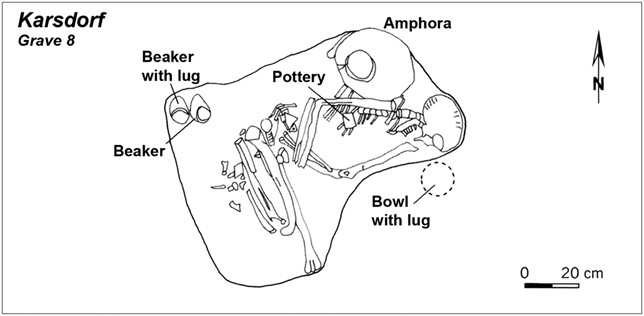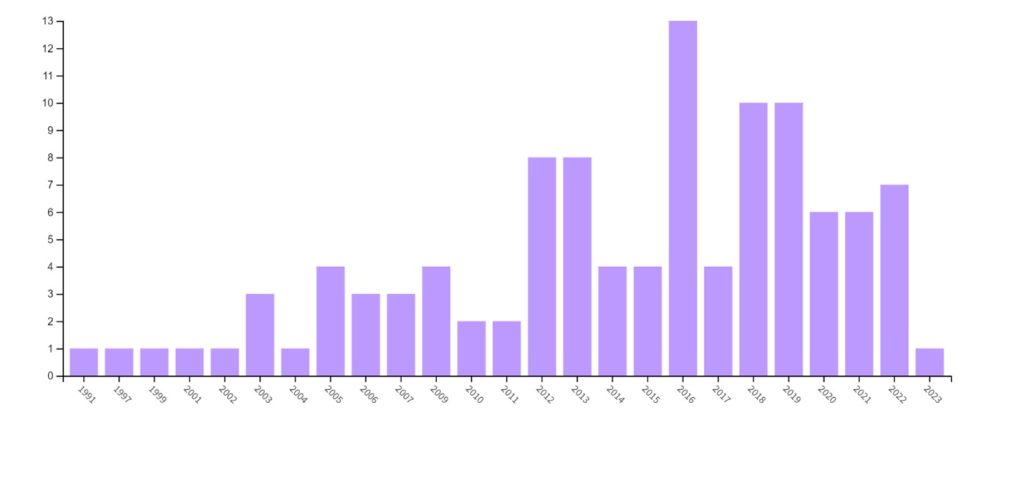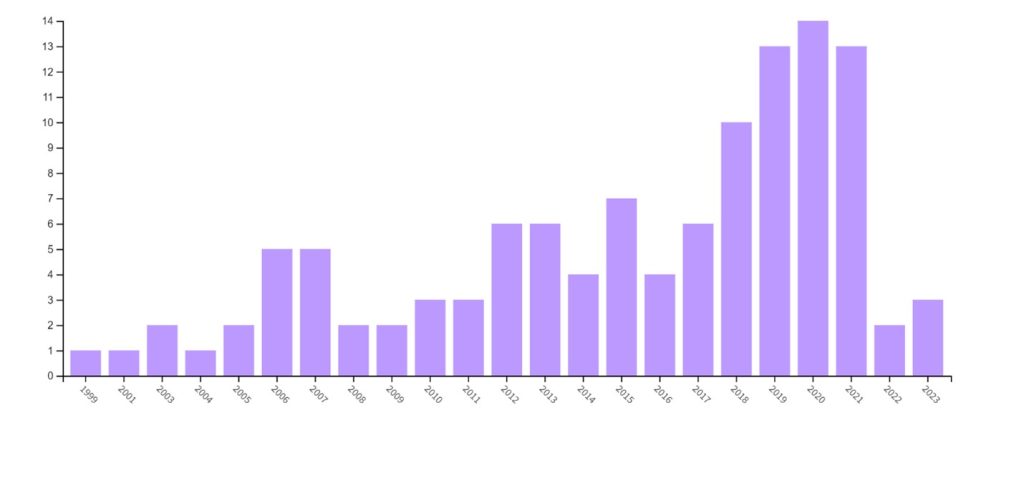An Anthropological Analysis of Violent Conflict Across Neolithic Europe
by Leonardo Umberger, Anthropology
For a long time, anthropology has been content with allowing prevalent theories to be based on assumptions or conclusions drawn from overly interpretive research. This pattern has allowed for many complex questions to be seemingly answered by studies that preferred to see humans as one or the other, violent or not violent, white or not white, civilized or savage. This culture of “grouping” in the discipline is changing, but recent and current research should still be critiqued with an eye towards preventing generalizations about human nature that anthropology has been so historically prone to making. This paper presents three recent case studies which focus on violence and conflict in central Europe during the Neolithic period, and an analysis of each which attempts to dispel the common narratives of interpersonal and group violence in this region around this time. I argue for the continued use of a nuanced perspective in these and future studies and dispute the commonly held belief that early humans were inherently violent or inherently peaceful. I also present a metanalysis of papers on this subject from the past two decades, and I analyze the trend in anthropological vocabulary as a signifier of changing research techniques. The paper supports the progression of new anthropological theories by the analysis of culture at the individual level through a biocultural approach to research.
neolithic, violence, anthropology, conflict, bioarchaeology
Traditional Theories of Human Violence
Whether or not humans are predisposed to live in peace or violence has been the subject of extensive theory and literature for thousands of years. Socrates argues with Aristotle, Rousseau with Locke, Lawrence H. Keeley with everyone else, and so on. After all of these years, one thing is finally clear: no one knows, or at least no one agrees. Historically, scholars have attempted to pinpoint the “beginning” of violent nature in humans, often settling on the Neolithic period, which ranged from approximately 10000 BCE to 2200 BCE. This paper does not seek to answer that seemingly eternal question of where war “started”, but it will present a grouping of case studies from Neolithic central Europe which may put into perspective the nuance of human violence through a biocultural lens. Violence can be and is defined differently on a scale of varying degrees–what constitutes a war versus a battle or an ambush from a siege, for example–but at any scale and every level violence is multifaceted and multilayered. To say that people are violent or people are peaceful by nature, or that it originated from one single circumstance in one single physical place, is to grossly oversimplify tens of thousands of years of complex human movement and settlement. There must be evidence and reasoning for times of peace and times of conflict. At the same time, to list these causes of violence or peace in checkable boxes is to smooth over the nuances of human relationships.
While these boxes do tend to represent trends in human history that create conditions which lend themselves to violent group conflicts, it is dangerous to assume these are the strict “causes” of violence in or among societies (Martin and Herrod 2015). Ultimately, every instance of violence should be considered individually within the specific social, economic, environmental, and physical contexts of their time and location. At the same time, the terminology surrounding the history of human violence must be reexamined. Specifically, war and violence must be discernably different both in the archaeological record and in research. I will argue, with the following case studies from neolithic central Europe as supporting evidence, that the asking of and answering the anthropological question of “are humans inherently violent” is an overly broad and somewhat useless venture, and that the discipline as a whole is realizing this and adjusting their studies accordingly throughout the decades.
To understand the significance of these case studies requires knowledge on how to read and interpret human skeletal remains and apply this interpretation to culture and lifestyle of the broader population. Luckily, there is a section of the discipline that is ideally positioned at that critical intersection of physicality and sociality and is able to get at the individual details of what makes culture tick. This so-called biocultural approach to studying violence can yield a much more specific picture of violence in society, both in its origins and in its consequences (Walker 2001). I will now give a brief how-to of skeletal trauma interpretation so that the presented case studies may be understood through a true biocultural frame.
How Bioarchaeology Allows Interpretation of Ancient Violence
When studying the bioarcheological remains of a conflict, there are many different ways to begin to piece together what exactly happened. Obviously, first look at the bones! Just by analyzing evidence of skeletal trauma visible to the naked eye, there is a very broad but very immediate and often accurate sense of the style and scale of the violence that took place. The three main types of physically identifiable trauma to the bone are blunt force, sharp force, and projectile force. While these types of injuries do also occur in cases of accidental injuries (falls or broken bones), instances of self-mutilation, or intra-species conflict, they are often indicative of intentional violence (Kjaerulff et al. 1989). Depending on the location of the wound and/or the direction of entry and exit wounds, a lot can be known about the severity of the attack and the defensiveness of the victim. However, time heals all wounds, even osteological ones. Bioarchaeologists can also tell a wound that occurred before the time of death, called an antemortem injury, from a wound that caused or occurred around the time of death, called perimortem, and a wound that was inflicted after death, an antemortem wound.
With all of these criteria for analysis of skeletal trauma, there forms a sort of standard by which bioarchaeologists can determine with relative precision the severity, type, and timing of the trauma at hand. These direct sources of evidence are free from the often interpretive and occasionally conjectural research of studies that rely heavily on literary or historical narratives of interpersonal violence (Walker 2001). However, that is not to say that these less bioarchaeological studies are inherently “worse science,” just as it is not true that research which leaves no room for historical interpretations is somehow “better science.” That is why the biocultural approach is so important when considering questions of human nature. A strong piece of work will consider every resource which is related to their area of study, and this means incorporating direct physical evidence alongside literary or even colloquial evidence (i.e., skeletons AND their stories).
The following presented case studies will attempt to analyze the severity and scale of human violence during the Neolithic period in Europe, and will support the assertion that Neolithic people were not the origin point of war, but rather that individual cases within the period represent an overall increasing trend in human capacity for violence at an organized and sometimes ritualistic level, a trend not necessarily caused by furthered reliance on agriculture in place of foraging lifestyles. A subsequent metanalysis of scholarly articles from the past decade will then serve to exemplify the changing definitions and connotation of the terms war and violence to more accurately reflect both large and small scale, as well as structured and unstructured instances of human conflict.
Case Study 1: Neolithic Southern Scandinavia: 3900 BCE-1700 BCE
“Southern Scandinavia is a region not usually given as much prominence in discussions on Neolithic violence as Central and Western Europe” (Fibiger, 2012:191), which makes it a unique and interesting case study. This study was done on 378 individuals from 87 population sites across southern and west-central Sweden, with 85% of the remains being of Danish descent. 90% of the individuals were adults, with 52% of the individuals being classified as male . The research focused mainly on skulls, as almost 100% of remains were found in mass burials, and so the other skeletal factors were conglomerates. The paper also notes that “in the absence of edged weapons, skull trauma can also be more confidently attributed to interpersonal violence compared to postcranial fractures” (Fibiger, 2012:195), so it is generally easier to analyze whole crania. A majority of the crania were in good to moderate condition, so the study was relatively unaffected by conjectural analyses of skulls that had been potentially disturbed by environmental or other inhibiting factors. The main points of comparison in this study were the differences and similarities in types of injury to the skull, location of fractures to the skull, and then gender-related differences regarding these injuries and their contexts. The male and female skulls showed an equal percentage of perimortem injuries. However, they found that the male population harbored many more antemortem injuries, located anteriorly on the skull. This may be indicative of males engaging in violence more frequently, but it is important to acknowledge that the risk for fatal injuries was equal across the sexes. The female injuries were mostly lateral on the right side of the skull and also antemortem. Typically, healed injuries can be indicative of accidental wounds or wounds incurred from self-defense. Similarly, injuries that have occurred on the right side of the skull are often interpreted as defensive in nature. The researchers note that while it may be tempting to look at these results and label the males as the “aggressors” and the females as “defenders,” it is important to remember that “the involvement of women as active participants in violent interpersonal conflict cannot be ruled out” (Fibiger 2012). Ultimately, this was a sweeping study that serves as a quiet rebuttal to the common assumption that Neolithic (and really any) violence is male-dominated and male-oriented.
Case Study 2: Neolithic Saxony-Anhalt, Germany: 5600 BCE-4900 BCE
Meyer and her coauthors present a detailed study of violence and trauma in the Corded Ware culture from Central Germany. The Corded Ware culture is one of the major archaeologically significant complexes of Central Europe. This study focused on mostly individual burials (with some multiple burials). The Corded Ware culture is known for its strict burial rites, with men being buried on their right side and females on their left side, both facing south. The remains of these burials are in excellent condition, allowing the bioarchaeologists to analyze antemortem and perimortem injuries in the population. The presence of flint and stone projectile points and weaponry embedded in situ in the skeletons was an indication of violent trauma at the site. Most of the perimortem injuries interpreted as causing death were accompanied by perimortem injuries to the ulna or radius and hand bones, suggestive of defensive movements or intense offensive violence. Most of the victims were adults with the exception of one male child, and the adults had a male majority but did include injured women. The researchers assert “the interpretation given here, namely that all of the individuals buried in the multiple graves at Eulau died as a result of a single, violent episode during the Late Neolithic” (Meyer et al. 2009:420). This may be true, but the sites at Eulau also serve as evidence that Neolithic people engaged not only in extremely violent organized behavior but also that death and burial were a ritualized part of these conflicts, as noted above regarding burial positioning. Alternatively, had the burials not been carefully positioned and ritualistic, it could be posited that the attackers left no survivors. Bodies that are buried with care are not buried by the enemy but by the people who remain in the aftermath, family and friends of the fallen. The multiple burials and manipulation of the positions and placements of skeletal remains provide a look into not just human trauma but human dealings with trauma in the way the dead are treated, and that is equally an important analysis of the site as parsing bone fractures.
Case Study 3: Neolithic Central Germany
Another study from Central Germany brings paleo surgical practices into the ever-expanding picture of Neolithic skeletal remains. Violence in humans is not always so cut and dry, and manipulation of the skull and bones can be just as harmful to the body (and the psyche) as a hammer to the head. The site at Karsdorf in Central Germany was studied, and it included 15 burials with stratified grave good and juvenile graves. The specific individual at the center of the study was a female in the Corded Ware culture of around age 55-65, buried with care among pottery and in a flexed fetal position.
Figure 1. Burial sketch of grave 8 with information on the location and orientation of the skeleton and the position of the grave goods (modified from Behnke, 2014; Nicklash et al. 2018).
The skeleton itself, in addition to bearing 3 healed antemortem blunt force trauma indentions on the skull, also had deep intentional groove cuts in the top of the cranium. The researchers noted that “All areas of the outer cranial vault concerned bear regenerative processes on the bone without any signs of abnormal bone remodeling.” (Nicklash et al. 2018: 220). This leads them to believe that they are manipulative trepanation marks performed antemortem in ritual. Due to the incompleteness of the groove (i.e., it did not fully penetrate the skull), researchers are able to identify it as what is termed “circular-zone” trepanation, so-called for the circular grinding motion that creates the style of groove seen in the victim. The presence of ritualistic violence like trepanation, although it is not deadly, is still representative of a slight but important shift in the Neolithic to a more violent human who engaged in more interpersonal conflict and organized violence. Even the fact that this particular case of cranial manipulation went unfinished shows that it was a regular process, allowing for mistakes and alterations in the form and style of the trepanation. Unfortunately, while we do not know exactly what this ritual represented or why it was performed, its existence is still evidence of a systematic skeletal manipulation practice. That is to say, the inconsistencies in this injury show that it is not a one-time occurrence, rather that it is indicative of the Corded Ware culture as a whole normalizing and incorporating violence into their daily lives and beliefs.
Metanalysis
An interesting caveat to discussing violence in bioarchaeology (and anthropology as a broader discipline) is that it is a versatile word that can be paired with a lot of descriptors. Structural violence, interpersonal violence, physical violence, organized violence, opportunistic violence; the list goes on. In light of these differences, one common and fatal flaw in literature discussing violence is that it can often be conflated for or substituted with “war” or “conflict.” This may at first seem pedantic, but the connotations behind war and violence are different and can often confuse the meaning, scope, or significance of the research if these two are used interchangeably. War, as defined by Miriam Webster, is “a state of armed conflict between different nations or states or different groups within a nation or state.” This implies war has a scalar aspect, a longevity aspect, and an organizational aspect, among others. Therefore, it is not entirely correct to say that Neolithic shift from foraging to farming made humans more “warlike.” Neolithic people did not engage in “war” as defined in modernity. It is important that we be as specific as possible in our research questions, hypotheses, and data recording so that studies can accurately say what they mean and mean what they say.
Anthropology has a troubled history as a discipline that tends toward vagueness (or did throughout the 20th century) and is slowly making its way towards scientific specificity. Because of this, I hypothesized that the number of articles in Web of Science which mention “Neolithic war” and “Neolithic Warfare” will not only be less than those that mention “Neolithic Violence” and “Neolithic Conflict,” but that these mentions including war will also decrease over time while mentions that include violence will inversely increase. This inversely proportionate relationship between the use of war and violence will reflect a broader trend in the whole discipline towards making research more specific and representative of accurate definitions. Below are quantitative representations of searches for papers in Web of Science.
Figure 2. A representation of the search results containing Neolithic War (X axis is the year, Y axis is the number of papers). The number of papers containing Neolithic War is trending down.
Figure 3. A representation of the search results containing Neolithic Violence (X axis is the year, Y axis is the number of papers). The number of papers containing Neolithic Violence is trending up.
As predicted, the overall number of papers under the search “Neolithic War” were less than the number of papers searched under “Neolithic Violence,” but not by much. The slim difference between the two numbers (109 and 115 for war and violence, respectively) was a little shocking at first. While most papers were using war and violence interchangeably, only a few used war to mean large-scale organized violence. One such paper defended the hypothesis of the origins of war being rooted in the Neolithic period by defining war as “collective violence…in this definition, that is to say an aggressiveness organized, managed, socialized and used for the group at the expense of a neighbouring group” (Beyneix, 2007:87). Although the paper did specify a definition of war, it can be troublesome to have one too many definitions floating around in academic writing. This only reinforces my argument that the term war should be used in an incredibly specific way to prevent oversimplifications but also overcomplications of research. Luckily, it does seem that this trend of individual definitions per paper is slowing down, and the use of violence as an overarching concept is increasing. This more focused definition of anthropological vocabulary will ultimately help achieve more individualized conclusions and results, which I argue is the better way to go about answering research questions. One standard, uniform use (or disuse) of such a heavy word as war will help refine papers and their impacts.
Conclusion and Discussion
The case studies chosen track the nature of early human society more fully than the simple “peaceful savage” into “warlike savage” archetypes of past anthropological literature. Each one in turn takes a different angle to violence in the Neolithic and allows for specific focus on aspects of culture and violence that may not always be considered when discussing the origin of war in humanity. Though it remains clear through these and other studies that Neolithic populations did not “invent” war, it is hard to argue that evidence of violence (organized, structural, and traditional) become far more prevalent in the archaeological record throughout the Neolithic than before. Evidence of weapons alongside injuries in German burials show that skeletal trauma is intentional, and that people spent time hurting each other and learning how to heart each other better. The lack of gender-based discrimination in fatal injuries to the bodies prove that women weren’t always only bystanders to male dominated violence. Tedious burials and surgical procedures present images of a human culture that go far beyond brainless barbarians with bludgeons and allow us a more nuanced view of what should be considered a sophisticated (if violent) culture and time. All of the socio-cultural interpretations of skeletal remains are what make bioarchaeology indispensable in determining the evolution of violence and culture throughout Neolithic Europe.
Lastly, it is worth noting that the need to pinpoint the origin of violence in a specific period of time or physical place is an attempt to prove a false underlying idea that to be violent is to be human. This paper serves to refute that point in favor of a more diversified understanding of violence throughout time and space. These case studies stretch across the entire continent of Europe, and there are dozens more which stretch across the temporality of European population, too. The human desire to find the origination of war, and the implications of it being in Europe, reinforces a false societal understanding that violence just is, and that it has always been. Anthropologists often place too much importance on studying human tendency towards organized and interpersonal violence, rather than studying individual cases and making smaller, more localized conclusions. This is a dangerous way of doing research because in a discipline so diverse and holistic, it can send research down a sort of academic rabbit hole in which no new theories are being accepted because the “right one” was already found.
In the same way Locke and Rousseau battled it out (though with a little more nuance), the anthropology of warfare should be about recognizing that there is not ever really a formula or a starting point to violence as human nature, and maybe the problem is that human nature cannot be researched in such a strict, standardized way. The tunnel vision of a lot of research is built on the idea that war and violence are interchangeable, and both have their concrete origins in Neolithic humans, both of which, if not already proven wrong, should be challenged more. Bioarcheology and subsequent bioarchaeological publications will allow us to more exactly get at what the causes and effects of Neolithic violence were, and provide a fuller, more complex picture of early human conflict. There is much more interesting work to be done on the bioarchaeology of war and violence, and it is forever worth remembering that even Neolithic Europeans aren’t as cut and dry as anthropologists today would like, and that challenging long-held theories in literature and research is what keeps science going.
References Cited
Boulestin, Bruno
2015 Cannibalism in the Linear Pottery Culture: The Human Remains from Herxheim. Oxford Archaeopress 152.
Beyneix, A
2007 Réflexions sur les débuts de la guerre au Néolithique en Europe Occidentale. L’Anthropologie 111(1): 79–95.
Fibiger, Linda, Torbjörn Ahlström, Pia Bennike, and Rick J. Schulting
2012 Patterns of violence-related skull trauma in neolithic southern Scandinavia. American Journal of Physical Anthropology 150(2): 190–202.
Janković, Ivor, Jacqueline Balen, Hrvoje Potrebica, James C. M. Ahern, and Mario Novak
2021 Mass violence in Copper Age Europe: The massacre burial site from Potočani, Croatia. American Journal of Physical Anthropology 176(3): 474– 485.
Kjaerulff H, Jacobsen J, Aalund O, Albrektsen SB, Breiting VB, Danielsen L, Helweg-Larsen K, Staugaard H, and Thomsen JL
1989 Injuries due to deliberate violence in areas of Denmark. III. Lesions. Forensic Science International 41: 169–180.
Martin, D.L. and Harrod, R.P.
2015 Bioarchaeological contributions to the study of violence. American Journal of Physical Anthropology 156: 116-145.
Meyer, Christian, Guido Brandt, Wolfgang Haak, Robert A. Ganslmeier, Herald Meller, and Kurt W. Alt,
2009 The Eulau Eulogy: Bioarchaeological interpretation of lethal violence in Corded Ware multiple burials from Saxony-Anhalt, Germany. Journal of Anthropological Archaeology 28(4): 412–423.
Christian Meyer, Olaf Kürbis, Veit Dresely, and Kurt W. Alt
2018 Patterns of Collective Violence in the Early Neolithic of Central Europe. In Prehistoric Warfare and Violence, edited by Andrea Dolfini, Rachel J. Crellin, Christian Horn, Marion Uckelmann, pp. 21-38. Quantitative Methods in the Humanities and Social Sciences. Springer Cham, New York City.
Nicole Nicklisch, Veit Dresely, Jörg Orschiedt, Frank Ramsthaler, Björn Schlenker, Robert Ganslmeier, Susanne Friederich, Harald Meller, and Kurt W. Alt
2018 A possible case of symbolic trepanation in Neolithic Central Germany. International Journal of Osteoarchaeology 28: 216– 226.
Walker, Phillip L.
2001 A bioarchaeological perspective on the history of violence. Annual Review of Anthropology 30: 573-591.
Acknowledgements
Dr. Laurie Reitsema, Adam Kazmi
Citation Style: SAA



